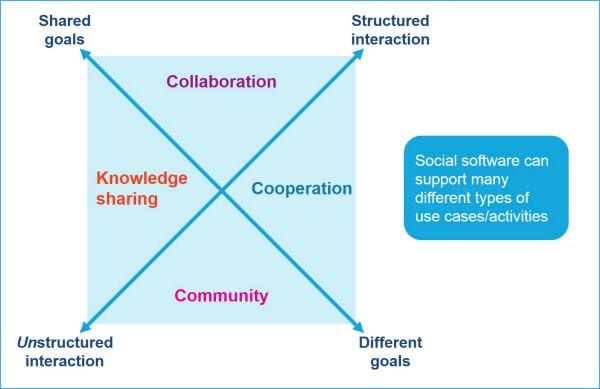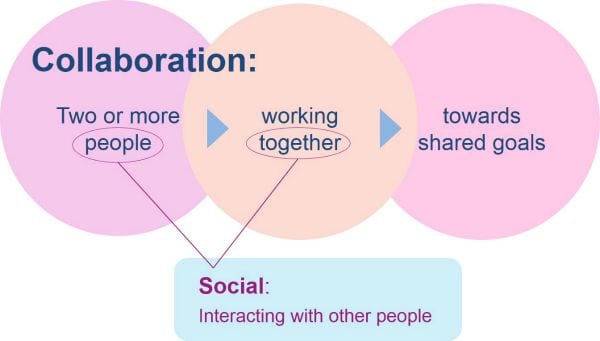Everybody please stop saying “social collaboration”

The phrase “social collaboration” confuses more than it clarifies and, in fact, hides more specific purposes of using enterprise social software. Digital workplace professionals should avoid the term and focus on more targeted business benefits of using social tools.
I’m not trying to be rude (it just comes naturally)
I know this post might ruffle a few feathers. But that’s not why I’m writing it.
I know and love a lot of very smart and successful intranet and digital workplace leaders who use the term “social collaboration”. The ideas in this article are not about the people who use this term, but instead represent my attempt to find clarity, meaning and truth in the language we use, so that we can do our jobs better.
Many of my friends and peers familiar with my occasional nickname of “the language police” will not be surprised I’m writing this post.
But I promise you, I don’t dislike the term “social collaboration” just for the sake of a good rant. I’m not writing this post just because I’m turning into an angry old man (not to say that’s not happening – I am regularly heard muttering “kids these days”, while drinking craft beer with fellow dads and feeling nostalgic for the days of telephone cords and modems that sounded like they were trying to communicate with extraterrestrials).
I actually believe that the phrase “social collaboration” muddies the water and obfuscates the purposes of using social software within organizations.
Perhaps the term has come into being for a good reason, as people try to better explain the modern use of social tools. But the reality is that it’s sloppy language and a poor synthesis for what we really mean.
From a lineage of unclear terminology
“Social collaboration” is one term in a long line of phrases the digital workplace industry has wandered through in trying to describe the use of social software within enterprises. In some cases new terms have sprung from academia, in others from software vendors and business consultants.
Other common terms related to “social collaboration” include:
- Enterprise 2.0 (the term that launched a thousand digital ships)
- Enterprise social software
- Enterprise social networking (ESN)
- Social intranets
- Social business
- Enterprise collaboration
- Etc.
Most of these terms fall into one of two categories: 1) They describe a specific type of software or activity; or 2) They are umbrella terms aimed at conglomerating many activities that use social software.
“Social collaboration” fits into the latter category, but I find it particularly harmful. Here’s why…
3 (good) reasons to stop saying “social collaboration”
#1: It’s linguistically redundant
I think language is important. I think communication is important. It’s what ties us together and can build shared understanding. I think we should say what we mean using the best possible words. And while I’ve often been accused of using too many words, I try to avoid terms that are simply redundant.
The term “social collaboration” is redundant. Why? Because the definition of “collaboration” encapsulates the meaning of “social”.
If you use the word “collaboration” you simply don’t need also to say the word “social”. Here’s my visual representation of the situation:

It’s important to remember that the word “social” simply means “interacting with other people”.
The word “social software” means “software that facilitates interaction with other people”.
And the fact that the definition of “collaboration” assumes multiple people interacting with each other means that you just don’t need to say “social”.
So, why have we in the digital workplace industry used the term “social collaboration” so much? For two reasons: 1) We’ve had trouble defining the more specific activities and purposes of using social software; and 2) We’ve, frankly, lazily created a term that helps us perpetuate number 1.
#2: It mashes together a software characteristic with a buzzword, but without creating any clarity

What we’ve basically done with the phrase “social collaboration” is tie together a description of a software category or characteristic (“social”) with a popular buzzword in business and management circles (“collaboration”).
We’ve done this partly because we expect executives to balk at the idea of implementing what they often assume to be distracting and unproductive “social” software within their organizations. By tying “social”, which triggers thoughts of hours wasted on Facebook, YouTube and ninja cats, to a business term executives are reading about in the Harvard Business Review, we’ve said “Hey, this is social software, but for business.”
Executives know they need to collaborate and innovate to drive dynamic synergistic value creation in the new digital economy, so their ears may perk up when you say “collaboration”.
Collaboration is a fine thing. I love collaboration and like to work collaboratively. Good collaboration is, in fact, good for business.
The problem is that “collaboration” is actually a poor explanation for many of the activities that we use social software for inside organizations. Which brings me to the crescendo of this argument.
#3: It hides clearer activities we should articulate and support
Intranet, internal communications, IT, knowledge management and digital workplace professionals have struggled mightily to convey the value of social software used within an enterprise. Many have felt very strongly about the introduction of social tools, even to the point of having the word “evangelist” in their official job titles.
Many of us have felt in our bones the potential benefits of social software, but as an industry we’ve struggled to define the ROI or explain the value.
That’s partly because social software is not one thing. Social software can be used for many different activities and can have many different impacts. And there are many different features of social software that cater to different types of interaction and related value.

Here are four common types of interaction that social software supports:
- Collaboration is what happens when people work closely together, specifically towards shared goals. Common examples include functional units, project teams and task forces. Some are long term, some are not, but the members of a collaborative team work closely together. Collaboration often happens within smaller groups with high levels of daily contact, rather than large groups with broad membership.
- Knowledge sharing is what happens when people try to transfer their know-how and understanding to other people. This definitely happens within collaborative teams, but most notably takes place among communities of practice. Communities of practice bring together people with shared roles and responsibilities to help them learn, spread innovations and improve performance more effectively.
- Cooperation is what happens when people with different goals align around some activity or project that will result in everyone getting what they need. Cooperation can happen among very broad groups of people and often requires reaching across some sort of boundary or border. It is more tenuous than collaboration because the bonds keeping people accountable are weaker. Sometimes cooperation is what you have if you can’t quite get people aligned around purpose and goals, and end up using a bit of coercion to keep people involved.
- Community is what happens when coworkers connect with each other, build emotional bonds and feel a sense of togetherness, voice and empowerment. Building community can happen within or across functions, teams and locations, and often increases employee engagement.
The problem is that each of these purposes for using social software can require very different toolsets and management approaches.
Examples of differing uses of social tools
One example comes from EY. You can read more in a DWG guest blog post by Tammy Young Heck on how EY measures Yammer success for knowledge sharing. At EY the focus is on supporting global communities of practice in strategic areas of the business. This means helping people with similar roles and skillsets connect to share ideas and innovations. These people are not generally involved in close collaboration with each other on a regular basis. Despite their similar roles, they probably work in different teams, in different locations, on different projects. Social software helps them share knowledge and connect when they need expert advice.
Here’s a very different example: during a confidential DWG members-only web meeting last week, a major US financial institution shared how it is building a “Collaboration Solutions Studio”. This function aims to help teams learn how to better use the digital tools provided by the organization.
This internal Collaboration Solutions Studio works with managers and their teams to understand the needs of teams and to define paths for improving work efficiency by shifting processes to using social digital tools. This work is about helping teams with clear purviews and goals collaborate more effectively.
As another example, when organizations enable employee comments on intranet news stories, it’s hard to argue that the functionality falls under the category of “collaboration”. Much more likely, giving employees a voice and enabling open conversations can contribute to a more inviting and inclusive work environment. It can help build community and employee engagement.
Similarly, a “kudos” forum where any employee can praise others for work well done is neither highly structured collaboration nor an example of knowledge sharing. But it can fall under the banner of “cooperation” and is a rich way to build community.
These examples describe different uses of social software that require different resources and approaches to management.
Calling all of this “social collaboration” is both inaccurate and lazy. “Collaboration” is not the correct word for describing all these uses of social software. And calling it “social collaboration” can even make it harder to measure and demonstrate the value of using social tools.
The Yammer trap
I think that in many cases we’ve used the term “social collaboration” as a stand-in for “Yammer” or some other threaded discussion tool.
This is because even a tool as simple as that can support a variety of different purposes and use cases. Yammer can be used for some types of collaboration and also provides an organization-wide social network. Instead of articulating the different benefits though, we just call it “social collaboration”. In this sense people focus on describing the tool, not the value derived from it or the activities it can support.
Yammer (and Chatter, SocialCast, etc.) can support several very different use cases, including:
- collaborative conversations among functional and project teams
- sharing knowledge among people in similar roles via communities of practice
- building community through affinity groups around work-related issues (working mothers; bike commuters) or fun, personal topics (Tuesday basketball league; knitting enthusiasts)
- communicating news through broadcast status updates.
Each of these uses yields a different benefit, the value of which must be measured in different ways.
And, Yammer is not the be-all-and-end-all of enterprise social software.
If you need to conduct digital brainstorming, you either need an interactive canvas like Boardthing or real-time online spreadsheets like Google Docs. If you need to collaboratively edit an agenda or write a client proposal, you need wiki-type interactive writing tools with version history and comments (or document check-out features). If you want to generate ideas about new revenue streams, ideation software is better than Yammer. And the list goes on.
Poor organizational design doesn’t help
It doesn’t help that the way most organizations are designed can actually hinder the proper management of collaboration, knowledge sharing and building community.
Common support functions such as HR, IT and Internal Communications traditionally have no capability to teach better digital collaboration, offer community management support, or foster online community.
Without explicit directives to support these needed activities that rely on social software, people often default to whatever industry buzzwords are out there right now. This is why I proposed in a recent blog post the creation of the Chief Employee Experience Officer (CEEO).
So what should we say?
I’m so glad you asked!
My basic proposal is simple: we as an industry and as individual digital workplace leaders need to tease out the different purposes and use cases for enterprise social software.
We need to define the potential benefits of those different purposes, identify executive stakeholders interested in those different benefits, and design different strategies around each of those benefits. And then, we can design more targeted metrics frameworks around each area of benefit.
Easy, right?
And instead of saying “social business” tell executives that you want to use social software to:
- improve productivity by helping teams collaborate better with digital tools
- drive learning and innovation around key business topics through communities of practice
- increase employee engagement by giving every employee a face and a voice in the digital workplace by supporting affinity communities and shifting internal communications from a one-way blow horn to two-way communications
- and other specific benefits
and try to provide examples of each.
As I said at the beginning of this post, I’m not denigrating the term “social collaboration” just because I happen to have a soapbox handy.
I believe that social digital work environments can make modern work more effective and meaningful. The digital workplace can help us connect with each other and actually feel more human. But we can’t do that if we let unclear industry buzzwords confuse our efforts.
So, go forth my friends and use Plain English to describe the specific benefits you’ll deliver with social software. Plan to support different types of use with different management and governance strategies. And know that in this context, where you make a solid business case, you can say “social software” without scaring off your executives.
Related research
[/one_half] [one_half_last]
[/one_half_last]
Categorised in: Collaboration


